Templar Sites
Semana Santa de Palma del Rio 2024

[Em Português mais abaixo]
The Magisterial Council of the OSMTHU, host of the Grand Priory of Spain and its Grand Prior General Fr+ José Miguel Navarro, took part in the traditional celebrations of Holy Week in Palma del Rio, Córdoba, at the invitation of the Brotherhood of the Holy Sepulchre of that Spanish town.

The Holy Week celebrations are one of the highlights of the Catholic liturgical year in Andalusia and famous worldwide for the exuberance and faith of its brotherhoods, who parade on the days of Passion wearing their characteristic liturgical robes, hoods, and long cloaks, accompanying the Lord’s Passions, concluding with the departure of the Dead Lord followed by the Virgin of Sorrows, in mourning. The Order took its place in the processions, despite the rainy weather that threatened to cancel the traditional procession.
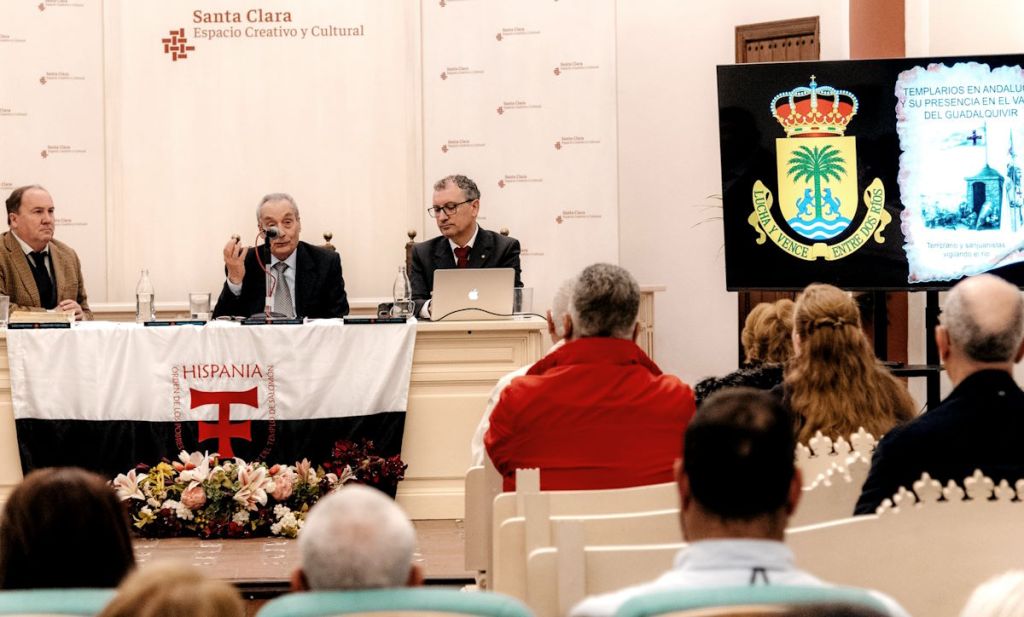
The OSMTHU joined in supporting this manifestation of faith. At the same occasion, a Conference was held, with the participatio of various different branches of the Order of the Temple from various countries, as well as a cultural event with the support of the Municipality of Palma del Rio, in which the Grand Prior Fr+ José Miguel Navarro, Commander of Lagos, Portugal Fr+ Victor Varela Martins, Chancellor Fr+ Luis de Matos (via video), Manuel Muñoz Rojo, Doctor in History and Corresponding Academic of the University of Córdoba, and writer/researcher António Galera García were speakers. These study and cultural sessions are expected to continue annually.
[Em Português]

O Conselho Magistral da OSMTHU, hospede do Grão Priorado de Espanha e do seu Grão Prior Geral Fr+ José Miguel Navarro, participaram nas comemorações tradicionais da Semana Santa de Palma del Rio, Córdoba, a convite da Irmandade do Santo Sepulcro daquela localidade espanhola.

As comemorações da Semana Santa são um dos pontos altos do ano litúrgico católico na Andaluzia e famosas em todo o mundo pela exuberância e fé das suas irmandades que desfilam nos dias da Paixão com as suas características roupas litúrgicas, de capuz e longos mantos, acompanhando os Passos do Senhor, concluindo com a saída do Senhor Morto seguido pela Virgem das Dores, em choro. A Ordem ocupou o seu lugar nos cortejos, apesar do tempo chuvoso que chegou a ameaçar a realização da procissão tradicional.
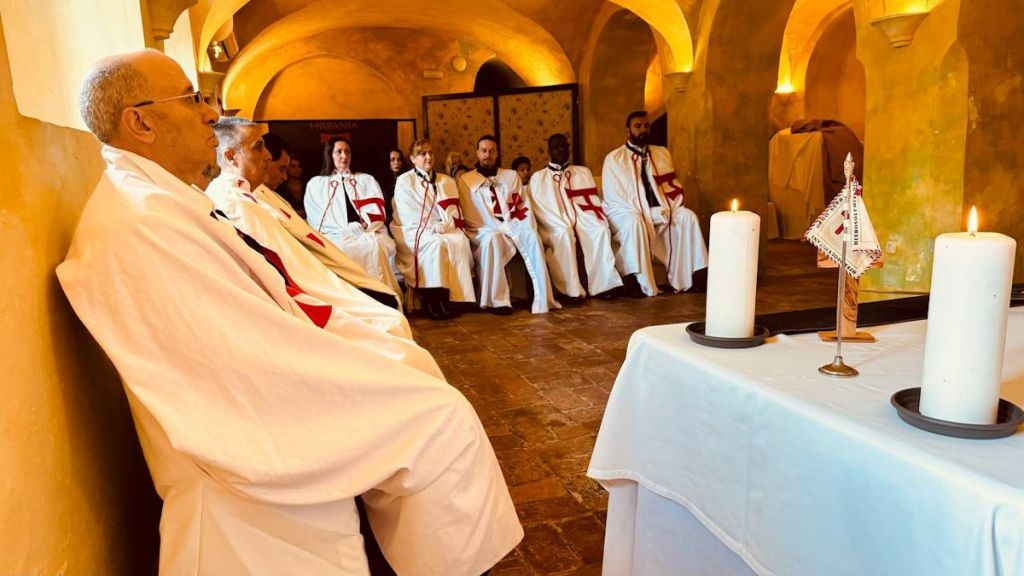
A OSMTHU juntou-se no seu apoio a esta manifestação de fé, tendo promovido a realização de uma Conferência entre vários ramos diferentes da Ordem do Templo procedentes de vários países, bem como um acto cultural com o apoio do Município de Palma del Rio, no qual foram oradores o Grão Prior Fr+ José Miguel Navarro, Comendador Fr+ Victor Varela Martins, o Chanceler Fr+ Luis de Matos (por video), Manuel Muñoz Rojo, doutor em História e Académico correspondente da Universidade de Córdoba e o escritor/investigador António Galera García. Estas jornadas de estudo e divulgação cultural deverão ter continuidade anual.
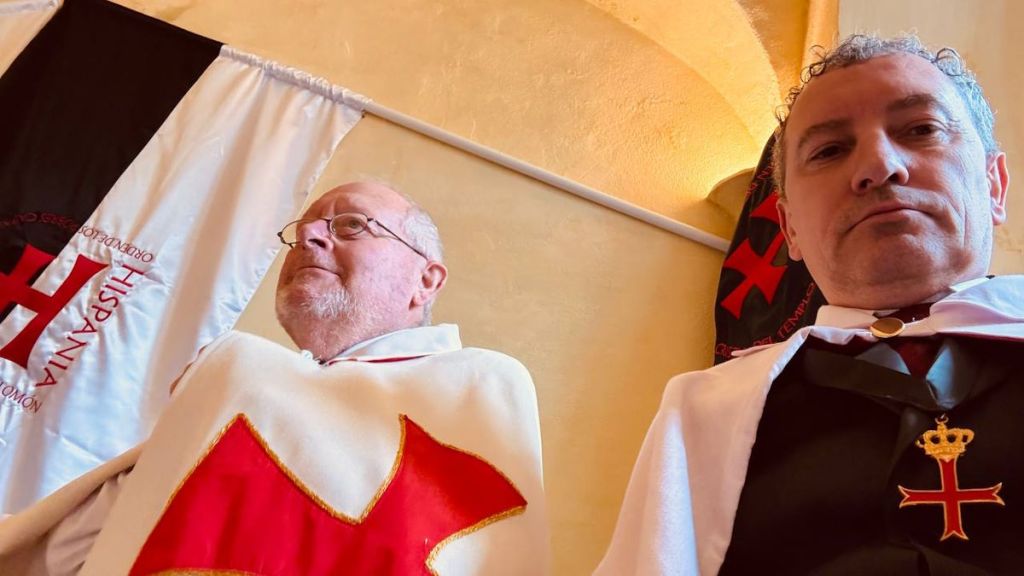
Video of the event:
Conference by Fr+ Luis de Matos, Chancellor OSMTHU [in Spanish]
Comemorações dos 705 anos da Ordem de Cristo e dos 30 anos do Grão Priorado de Portugal da OSMTHU

Decorreram esta semana as comemorações dos 705 anos da Ordem de Cristo e dos 30 anos da criação do Grão Priorado de Portugal da OSMTHU, em vários lugares do Algarve sob a égide da Comenda de Lagos.
No dia 14 a Comenda promoveu uma Conferência em conjunto com a Câmara Municipal de Lagos acerca da Ordem de Cristo e do Infante Henrique de Sagres, com uma intervenção de fundo de Luis de Matos, Grão Prior de Portugal, escritor, conferencista e conhecido pela sua abordagem simples e aberta às temáticas da Cavalaria Espiritual. Contámos com a presença da Vereadora Drª Sandra Maria Almada de Oliveira, da Câmara Municipal de Lagos, trazendo a celebração da Ordem de Cristo a Lagos e associando a Autarquia aos festejos, o que a Ordem do Templo muito preza.
Transmitida em directo através da página de Facebook da Comenda (https://www.facebook.com/comenda.laccobriga), rapidamente se tornou viral nos Grupos acerca de Templários e quando encerrou tinha registado 1.400 espectadores simultâneos, chegando ao final do dia com 4.000 visualizações e, 6.600 ao final de 3 dias, o que é um record absoluto para transmissões ao vivo desta Comenda.

De registar que mais de 20% dos espectadores têm IP no Brasil, com vários países acima dos 5%, incluindo aqueles onde as Comunidades Portuguesas são mais numerosas. As maiores congratulações são devidas ao Comendador Fr+ Victor Varela Martins e à sua equipa, incluindo os Preceptores locais, que, apenas duas semanas após as VI Jornadas Templárias, mostraram mais uma vez capacidade organizativa e empreendedora de que a Ordem se orgulha. Registou-se também a presença do representante do Comandante Regional da GNR e de diversas associações locais, assim como da Liga dos Combatentes, em Lagos e Castro Marim.

No dia 16 as actividades centraram-se em Castro Marim, que foi a primeira sede da Ordem de Cristo, a partir de 14 de Março de 1319. O dia iniciou-se com a inauguração no Posto de Turismo de uma exposição temática sobre os 30 anos do Grão Priorado de Portugal da OSMTHU, constituída por 7 painéis explicativos que irão viajar pelo país ao longo do ano de 2024 e 2025 levando o tema Templário a várias autarquias de norte a sul.

Com a presença do Vereador João Manuel Afonso Pereira, responsável pela Cultura, que sublinhou o aprofundar da colaboração entre a Ordem e a Autarquia desde a primeira Conferência Anual em 2019, o Grão Prior teve oportunidade de falar um pouco acerca da Ordem de Cristo e da singularidade da passagem de testemunho entre a Ordem do Templo e a missão marítima que viria a caracterizar Portugal no século XV.


Pela tarde o Ramo Secular da Ordem abriu o seu IV Capítulo Nacional, em que se discutiram temas relacionados com o plano de trabalho da Ordem para os anos de 2024 e 2025, reforçando as diversas linhas de acção, que incluem a Ordem Soberana, o seu papel no âmbito internacional e nacional, o Ramo Secular e o trabalho humanitário desempenhado pelo Templar Corps. Estiveram presentes os Comendadores do Grão Priorado Soberano de Lagos, Lisboa (Chagas) e Arraiolos, bem como o Grão Preceptor Nacional que teve a oportunidade de dar uma panorâmica acerca do Programa de Estudos interno, que vem adicionar novos recursos ao notável trabalho executado pelo anterior Preceptor, que inclui conteúdos exclusivos de base histórica e espiritual, bem como a plataforma online que permite o acesso permanente e remoto a toda a informação, segundo o grau de cada utilizador.

O dia acabou em muito boa disposição com um Banquete Medieval na Taberna do Velho Cavalinho do Fr+ Carlos Carmo, um eterno Templário e generoso anfitrião, divertido apaixonado pelo medievo, incansável divulgador da Ordem e de uma das épocas mais mal compreendidas da nossa História. Entre iguaria e bebida farta, se prolongou até altas horas a animação e o convívio fraternal.

Afinal, o homem tanto precisa de disciplina e ordem, como de um sincero sorriso e alegria no coração. Assim foi em Castro Marim. Que a Ordem prospere.

Ficam de seguida as mensagens a propósito da ocasião do Comendador de Laccobriga, Fr+ Victor Varela Martins e do Perceptor de Castro Marim, Fr+ Bruno Correia.

Fr+ Victor Varela Martins, Comendador de Laccobriga
Irmãos do meu Coração,
Foi muito bom poder contar com a vossa presença, tanto física quanto no apoio espiritual, nestes dias !!!
Cumprimos um ciclo ao Sul, no início de cada ano pedimos um esforço maior a todos os Irmãos para que se desloquem ao Algarve entre Fevereiro e Março mas é por um bem maior, um bem maior do que nós mesmos, é pelo nosso Priorado e pelo nosso Domine comum, é pelo Propósito da Cavalaria e de tudo o que Ela Representa…
Obviamente que cada um de nós sai reforçado, pois embrenhamo-nos de Amor Caritas, de expressões de Fraternidade e recarregamos a Energia e reforçamos a Cavalaria em nós próprios !!! Como Todos sabemos, Amar é ir ao Mar, e lá ir não é somente vê-lo é sim comungar dele, molharmo-nos… e é por isso que iniciamos o ciclo anual por aqui. Venha daí um bom ano para cada um de Todos nós e para a OSMTHU.
Não somos muitos, mas os que somos somos no número certo para fazer ressoar e manter viva a Cavalaria Espiritual e o Propósito do Templo hoje.
Um obrigado muito sentido ao Sereníssimo Grão-Prior e aos Oficiais do Priorado pelo apoio e por manifestarem sempre esta misericórdia para com os Irmãos do Algarve.
Agora vamos ao trabalho que o mundo ainda necessita de Nós.

Fr+ Bruno Correia, Preceptor de Castro Marim
Que a graça do nosso Senhor Jesus Cristo, o amor de Deus e a comunhão do Espírito Santo sejam com todos vocês.
Desde já quero agradecer humildemente ao nosso Digníssimo Grão Prior, ao nosso Respeitável Comendador de Laccobriga, pela caridade e pela dedicação, que dispuseram para que fosse possível comemorar/relembrar mais um aniversário da Instalação da Ordem de Cristo em Castro Marim.
Quero também agradecer a presença do nosso Solidário Preceptor Geral, os Respeitáveis Comendadores de Arraiolos e de Chagas, assim como a nossa irmã Dama, os nosso irmãos Cavaleiros e a nossa irmã escudeira.
Obrigado a Todos, de Coração, por terem contribuído para que a Tradição não fosse esquecida.
Christi Pax


IV International Conference in Almourol

The weekend of the 13, 14 and 15 of October 2023, the Templar Interpretation Center of Almourol (CITA), Portugal, was host of the IV International Conference on Spiritual Chivalry, Templars and Templarism. For three days, scholars, specialists and the public were able to hear about new research on the Templars and debate a wide range of topics. Four new books were presented, including an expanded reprint of the original catalogue of the 2019 exhibition, that had since been out of print. The Conference is the largest and most prolific international Templar Event.

The Conference started on the evening of Friday 13, with the Mayor of Vila Nova da Barquinha, Fernando Freire, welcoming speakers, the public and members of the OSMTHU, whose Master, António Paris, attended the event. He remembered the date and the imprisonment of the Templars, adding that in 1195 Master Gualdim Pais died in Tomar on the 13 of October as well. Writer and Past CITA Curator Manuel J. Gandra, gave a brief presentation about the Conference and the topics to be discussed in the next couple of days, presenting the reprint of the first catalogue. Master Antonio Paris, who had flown from Rome to attend the event, spoke briefly about the importance of the event and the opportunity of cooperation presented by the fact that several branches of the Order today were invited to come to Almourol and share the knowledge and passion about Templar history and values. On midnight the Grand Priory of Portugal of the OSMTHU conducted a short, but evocative ceremony, in memory of the fallen Templars.
The proceedings started on Saturday, 14 with the presentation by Dom Nuno de Bourbon da Camara Pereira of a paper titled “The Saga of an Order of Chivalry of the 21st Century” about the recent history and court disputes of the Order of the Wing of Saint Michael. Founded in the 12th century by King Afonso Henriques, the Order was revived several times in history and had been in the center of a dispute between Dom Duarte Pio, head of the house of Braganza, and Dom Nuno Bourbon, founder of the last revival of the Order in 1981. The dispute was recently settled out of court, with the mediation of the Archbishop of Evora, resulting the the full reinstatement of rights to Dom Nuno as its Grand Master.

French writer and researcher Remy Boyer followed suit with “Figures of Perceval, archetype of the Knight”, a deep piece on the evolution of Perceval within the Quest, with all his adventures and challenges, a blueprint for Chivalric Initiation. The dichotomy between the Grail and the Spear was explained and the question of “who does the Grail serve?” that had to be formulated by Perceval once he saw both objects during the Fisher Kings banquet, pointed out as one of the symbolic keys of the Quest.
Heraldist David Fernandes da Silva spoke about “Catechesis and Confraternity, Examples and Thoughts”. He explained the role of catechesis as a source of testimony and the chain of tradition for the early communities, projected along the ages, giving some examples related to the Templars, including the “Non Nobis…” Psalm and the usage of the patée cross. He then explored the matter of the Templar brothers that were not professed but lived under the rule of the Order in Templar houses. To this level he called the “confraternity” as opposed to the “fraternity” of those who received the ordination.
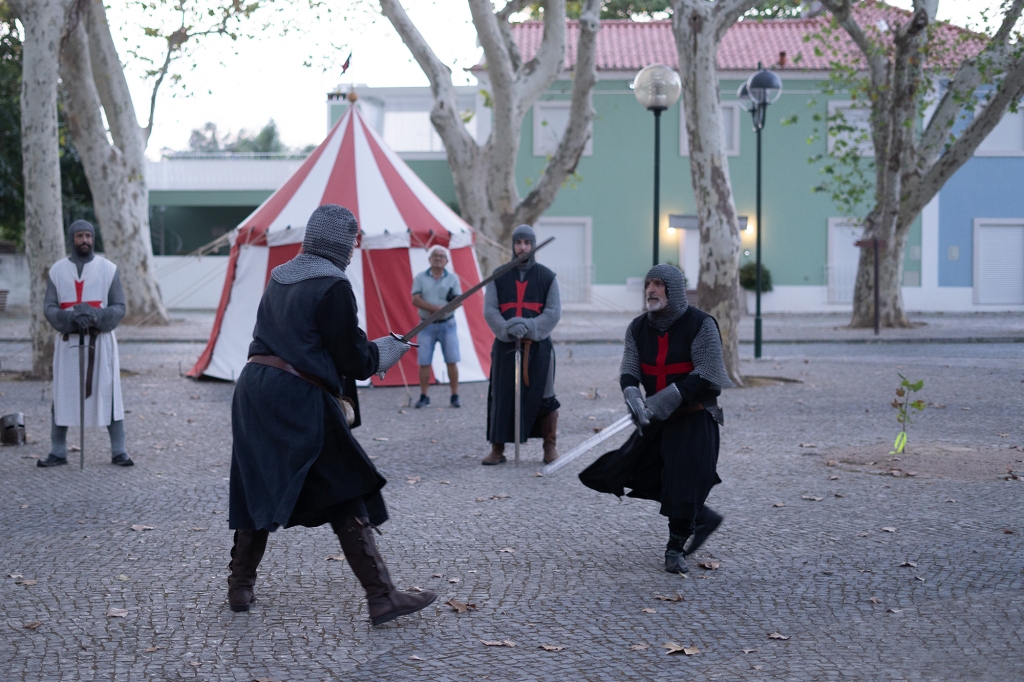
After lunchtime the Templar Encampment was opened in the courtyard in front of the auditorium. For two days the Tomar Honoris group from Portugal and the Baucan group from Spain staged medieval reconstitutions that included dances, games and the reenactment of sword fight techniques.

The afternoon opened with João Pedro Silva, past Preceptor of the Portuguese Grand Priory, who gave a very detailed view of the procedures against the Templars in France, in his “The Templar Processus”. All the motivations by Philipp, the Fair and his dealings with Bertrand de Got (later Pope Clements V) were outlined. The subsequent fight for domination of the court proceedings between King and Pope, both wanting to be the ones spearheading the events, was explained. The account of the last days of the process and the eventual suspension of the Order was also detailed, giving the audience a vivid account of a subject that is usually wrapped in misinformation and attempts to oversimplify one of the most compelling court procedures of the middle ages.
The day finished with researcher and Associação Saudade’s VP, Virgílio Alves, and his “The Cathars in Portuguese Templar Territories”. In a long and detailed research paper, Virgílio Alves gave the audience the origins, context and history of the Crusade against the Albigensis in the 13th century, focusing then on the escaping Cathars and the help provided by the Order of the Temple, including in escorting a large number of “bons hommes” to the Portuguese region of Castelo Branco, logistical headquarters of the Portuguese Templars.
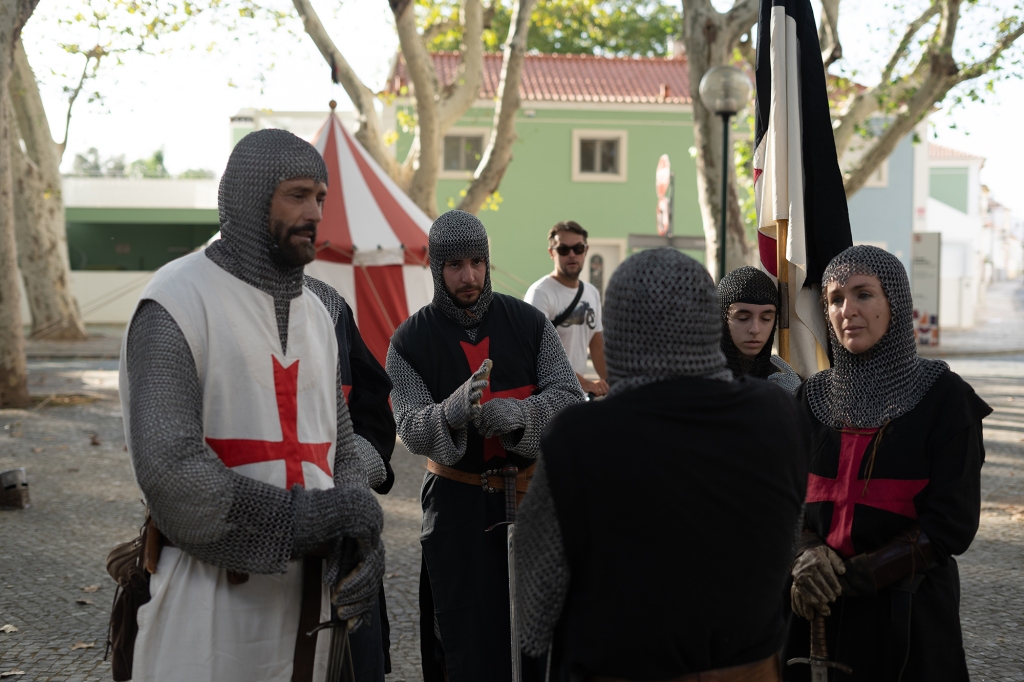
On the 14th, Sigillum Templi’s president Victor Padilla Nieto from Spain opened the proceedings with his “Tacuinum Sanitatis, and its influence on the Templar Order”. It was a presentation that exposed the influence of the Tacuinum Sanitatis, a set of ancient sanitary rules related to food preparation and health habits, that was fundamental for the Primitive Rule’s prescriptions on hygiene and food on the daily life of the Order.
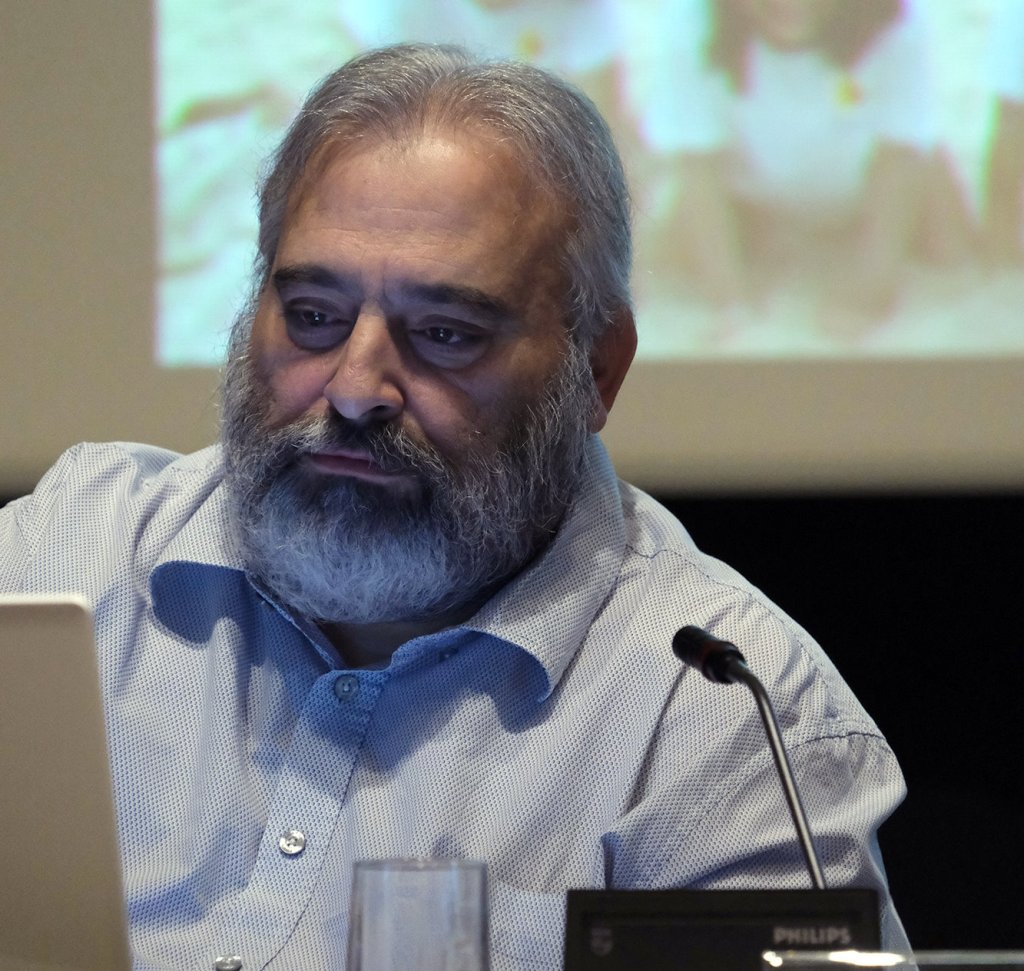
Luis de Matos, International Chancellor of the OSMTHU, spoke next remembering a short passage of the letter of Bernard of Clairvaux to the Templars in which the military actions of the Order are justified by Christs own rage in the Temple (Mathew 23). He then expressed how that passage is also an inspiration when it comes to the state of Templarism in the world today, setting himself apart of the whole movement – that he said to be incapable of defending or representing. He concluded by stating that it’s increasingly difficult and alienating to be a traditionalist in Portugal, giving a few examples of how the authorities mishandle the administration of culture and old Templar monuments in the country.
The last leg of the Conference was opened by Bulgarian Professor Yuri Stoyanov, of SOAS University of London, who offered the paper “The Importance of Russian and Eastern European Museum and Archival Collections for Study of the Historical Knights Templar, Spiritual Chivalry and Templarism”. He traced the importance of many pre-war archival sources on Chivalry and Templarism that were scattered and disappeared after World Wars I and II. Many of these have since surfaced in Russia and Poland and hold critical information on subjects such as the 18th century Swedish (Templar) Rite of Freemasonry, the Order of Malta tradition in Saint Petersburg and the Templar Orders of the early 20 century in Russia.

The Conference was closed by researcher Manuel J. Gandra with his “Did the Templars Profess a Secret Doctrine? Thoughts on a Loaded Topic”. By dismissing right from the start the two main popular references to a secret doctrine in the Order: the Baphomet, the Statutes of Master Roncelinus, Gandra was able to concentrate on the several failed attempts made by revivals of the Order in the 18th and 19th century to be recognized the the Portuguese Order of Christ, as the sole legitimate pure lineage at the time. By studying archeological findings made at the Almourol Castle and architectural iconographic elements still visible in the Convent of Christ – including those of an hermetic and rosecroix background over 100 years older than the German Manifests – Gandra explored some of the canons of a doctrine that is visible and intelligible in Portuguese Templar sources, but unknown to the scholars still today.
Overall, the IV Conference was an absolute success. It was heavily attended, the communications were original, interesting and informative and the conversations that took place during the intervals show great promise for future projects about the Templars. Next year, put it on your calendar: 13 and 14 of October 2024 the destination is Vila Nova da Barquinha / Almourol, Portugal.
Projecto Radio-Amador do Diploma Castelos Templários Portugueses completa 5 anos

Parabéns à equipa de gestão do Projecto. São cinco anos a realizar uma caminhada de divulgação do legado material Templário através das comunicações de Amador.
O DIPLOMA DOS CASTELOS TEMPLÁRIOS PORTUGUESES nasceu do desejo de Rádio-Amadores portugueses darem a conhecer o belo e inestimável património, o legado que a Ordem do Templo edificou no medievo e que chegou até nós. Um projecto para os Amadores da rádio de todo o mundo. Desde a primeira hora contou com o apoio do Grão Priorado de Portugal da OSMTHU.
A aceitação tem sido fantástica ao longo destes cinco anos, tanta que este grupo tem um elevadíssimo número de seguidores que nada conhecem de rádio, nunca usaram ou viram um emissor mas que nutrem um gosto e interesse genuíno pela herança recebida dos nossos antepassados medievais. Que as comunicações sejam sempre fluídas e que sejam lançadas pontes electromagnéticas entre os Homens de boa-vontade de todos os quadrantes, de todas as crenças e ideologias, como o Rádio-Amadorismo sempre e bem sabe promover!
Contamos convosco no Diploma para continuarem a ajudar a divulgar este ideal de Cavalaria. Parabéns pela obra feita!!!
Feliz dia para Todos os membros Amadores e não Amadores. Boas comunicações.
E que o vosso entusiasmo e capacidade seja um exemplo daquilo que tem de ser, toda a acção motivada pela Ordem e com o fim de que tudo se submete ao Altíssimo.
Todas as reações:
9Tu e 8 outras pessoas
Convento de Cristo 2023

Informações: incursoeshermeticas@gmail.com
A partir de hoje, os visitantes do Convento de Cristo, em Tomar, já poderão apreciar a fachada ocidental da nave manuelina, que inclui a famosa Janela Manuelina, ou do Capítulo, após obras de restauro na ordem de um milhão de euros. Venha connosco no dia 27 descobrir os segredos do Convento de Cristo. Visita guiada por Luis de Matos.
27 Agosto, 10:30h; Visita guiada: 35€ [Entrada no Convento de Cristo é gratuita ao Domingo; levar Cartão de Cidadão]; almoço livre; a visita termina pelas 18h
Inscrições: incursoeshermeticas@gmail.com
Rota dos Templários. Castelo de Almourol já pode ser visitado numa sala a três dimensões

Vila Nova da Barquinha continua a inovar no setor do turismo. Registo, neste particular, para mais uma mais-valia que é colocada à disposição dos turistas – e não só – principalmente para todos quantos, por questões de mobilidade, não podem visitar o Castelo de Almourol. Está, assim, em causa a inauguração de uma sala de visita imersiva, a 360°, nova acessibilidade que agora é realidade no Centro Cultural, precisamente no Posto de Turismo, num edifício que já tem o Centro de Interpretação Templário de Almourol, sem dúvida uma das maiores atrações histórico-culturais do concelho e do Médio Tejo. E foi perante uma atmosfera Templária que Fernando Freire, presidente da Câmara de Vila Nova de Barquinha, abriu a sessão propriamente dita, referindo que a Rota dos Templários se pretende assumir como um produto turístico, reforçando que está em causa um trabalho de equipa. Jorge Simões, segundo secretário da Comunidade Intermunicipal do Médio Tejo, fala da concretização de um trabalho muito importante, mais ainda para pessoas que não conseguem, por meios próprios, visitar o Castelo de Almourol. Pedro Machado, presidente da Entidade do Turismo do Centro de Portugal, também marcou presença e destacou o papel relevante de cada um dos municípios da região, reforçando que Vila Nova da Barquinha tem um conjunto de componentes de ativos diferenciadores. Assista ao vídeo editado pela nossa redação.
Escrever na Agenda: Visitar a Taberna Medieval Velho Cavalinho em Castro Marim
Entrevista do Irmão Fr+ Carlos Carmo, KTJ, dono da Taberna Medieval Velho Cavalinho, ao Canal Ayamonte Interesa. Para uma experiência gastronómica e cultural única. Em Castro Marim, junto ao Castelo da Ordem de Cristo.
Castelo de Montalvão Activado no Projecto do Diploma dos Castelos Templários de Portugal
O Projecto do Diploma dos Castelos Templários de Portugal realizou mais um activação que decorreu entre os dias 19 e 21 de Maio de 2023. Desta vez as actividades centraram-se no Castelo de Montalvão, que se junta assim a uma larga lista de fortificações Templárias ligadas à vasta rede de Rádioamadores do mundo inteiro.

Diploma dos Castelos Templários de Portugal
É um programa e um projecto dedicado ao Rádio-Amadorismo, idealizado e realizado por Amadores de Rádio titulares de Licença de Radiocomunicações de Amador com um interesse particular na Ordem do Templo e no seu legado edificado em Portugal, que desde 2018 tem vindo a levar o nome de Portugal e da Ordem do Templo aos quatro cantos do mundo.
Os Amadores desenvolvem projectos temáticos para promover as comunicações entre diferentes partes do mundo, em que o uso dos rádios de Amador servem de ponte para aproximar culturas, pessoas e estreitar laços entre aqueles que se dedicam ao Rádio-Amadorismo. Foi com o objectivo de divulgar o vasto e rico Património material da Ordem do Templo existente em Portugal que dois Amadores – CT7ABF e CT2ISX – idealizaram a criação deste Diploma, aos quais se juntaram outros Amadores e não-Amadores de rádio. O Diploma será atribuído a todos aqueles que efectivem um conjunto mínimo de contactos rádio (confirmados através da troca de cartão QSL) sempre que seja “activado” um determinado castelo (constante do Regulamento).
Para além do Diploma (objectivo máximo a alcançar por aqueles que o almejam) o Projecto atribui um Cartão QSL a todos os contactos estabelecidos em cada activação de cada Castelo Templario.
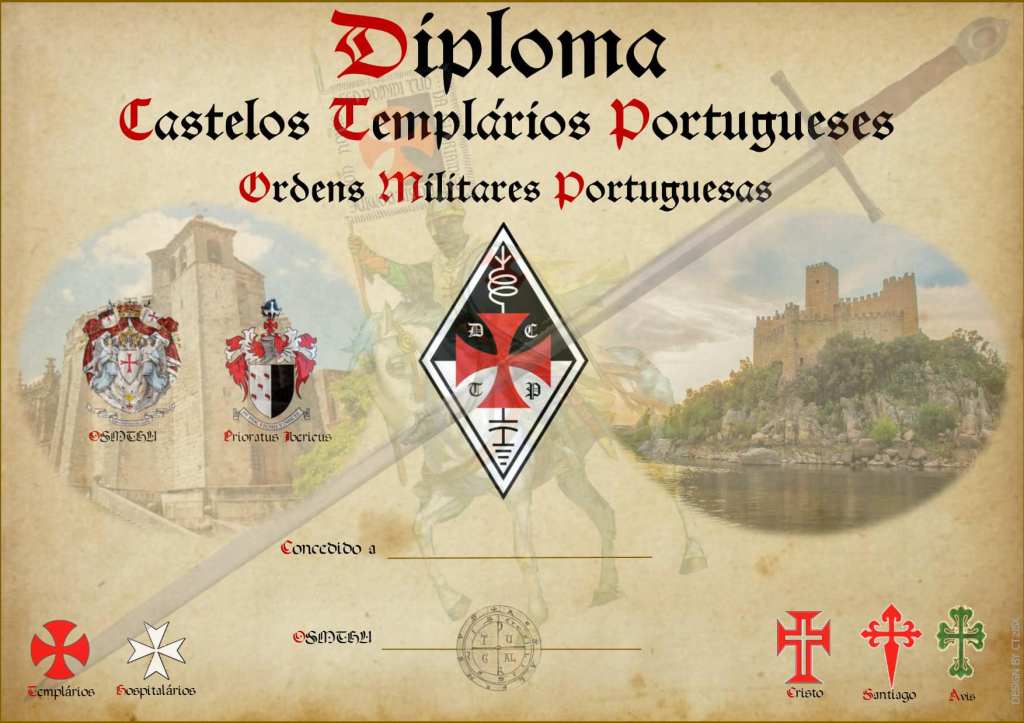
A OSMTHU ofereceu a sua chancela para atestar a idoneidade e o reconhecimento da Ordem a este nobre e interessante projecto. Pelo que o Diploma e os Cartões QSL seguem com o Brasão de Armas da Ordem e do Grão-Priorado de Portugal. Da mesma forma incentivamos os Rádio-Amadores de todo o mundo a participarem nas activações dos diferentes castelos Templários Portugueses que periodicamente recebem os Amadores e os seus equipamentos de rádio e que estabelecem comunicações de dentro do espaço do Castelo até um qualquer ponto do planeta onde esteja um interlocutor interessado em conhecer Portugal, o Castelo e a Ordem dos Templários.
Quando a Sociedade Civil quer e é apoiada, suportada, coisas boas podem ocorrer.

Lista dos Castelos Templários Portugueses activados para o mesmo Diploma.
– Torre Templária da Quinta da Cardiga.
Com indicativo especial CS2 TTC, em 12/10/2018, a 14/10/2018.
– Castelo Templário de Castelo Novo.
Com indicativo especial CS2 TCN, em 7/12/2018 a 9/12/2018.
– Castelo Templário de Soure.
Com indicativo especial CS2 TCS, em 22/03/2019 a 24/03/2019.
– Castelo Templário de Tomar.
Com indicativo especial CS2 TCT, em 22/03/2019 a 24/03/2019.
– Castelo Templário de Santarém.
Com indicativo especial CS2 CTS, em 22/03/2019 a 24/03/2019.
– Castelo Templário de Castelo Branco.
Com indicativo especial CS2 TCB, em 22/03/2019 a 24/03/2019.
– Castelo Templário de Castro Marim.
Com indicativo especial de CS2 TCM, em 22/03/2019 a 24/03/2019.
– Torre Templária de Quintela.
Com indicativo especial CS2 TTQ, em 17/05/2019 a 19/05/2019.
– Torre Sineira de Dornes.
Com indicativo especial CR6 TD, em 31/05/2019 a 1/06/2019.
– Castelo ” Templário “ Sortelha.
Com indicativo especial CS2 1TS, em 11/10/2019 a 13/10/2019.
– Castelo Templário de Monsaraz.
Com indicativo especial CS2 CTM, em 7/12/2019 a 9/12/2019.
– Castelo Templário do Mogadouro.
Com indicativo especial CS2 CMT, em 14/05/2020 a 17/05/2020.
– Castelo Templário de Celorico da Beira.
Com indicativo especial CS2 CTCB, em 5/11/2021 a 7/11/2021.
Boas comunicações para todos,
73, 51, 88
Pentecost 2023 in the Grand Priory of Portugal OSMTHU

No words can translate the joy in having new Brothers and Sisters enter the House. This Pentecost we had one Novice, one Squire, six Knights/Dames and 13 Brothers and Sisters Professing their faith. The ranks expand. In silence and seclusion we advance, we keep the flame alive, pure and whole.

Many things were said, many wise words of ancient masters were read, the Gospel was recited and Pentecost in Palestine in 33aD was remembered. But none of us was prepared for the moment when the closed doors of our church were not an obstacle for a couple of swallows, one dove and an unidentified other bird who suddenly flown in, rejoicing in a swirled flight, chirping and flapping their wings, in what sounded like the blow of a strong wind echoing in the silent church. We all looked up and smiled. The dove stayed all night, accompanying those making Vigil. In the early hours of morning, as we prayed the “Veni Creator Spiritus”, the dove was cooing in comfort. After all, it was Pentecost.

Congratulations to new Knights F+ João Gonçalves, KTJ; Fr+ Bruno Correia, KTJ; Fr+ Nelson Rosado, KTJ; F+ Valter Luz, KTJ and Dames S+ Maria José Rocha, DTJ; S+ Maria José Viegas, DTJ. Congratulations to new the new Commander of Lisbon – Chagas, Fr+ Fernando Silva, KGOTJ, also installed as Grand Master of Ceremonies. Congratulations to Fr+ Paulo Fernandes, KGOTJ, installed as Grand Seneschal.

Comenda de Laccobriga e Templar Corps em Festa Quinhentista

A Comenda de Laccobriga da OSMTHU e o Outpost do Algarve do Templar Corps International marcaram este ano a sua primeira participação na Festa Quinhentista de Lagos, organizada pela Câmara Municipal de Lagos.
Com base no Forte de Lagos, vigia junto à foz da Ribeira de Bensafrim, um grupo de voluntários recriou uma reunião do Capítulo da Comenda de Lagos da Ordem de Cristo e o seu ambiente, com mobiliário, decoração e figurantes trajados à época. A sala foi igualmente disposta de modo a poder responder às perguntas dos visitantes, dando-lhes uma visão mais detalhada acerca da Ordem de Cristo e da sua herança ancorada no Ordem do Templo. Vários painéis informativos foram colocados nas paredes, traçando a história das Ordens.


Da informação recolhida, todo o numeroso público visitante saiu mais rico e culturalmente mais esclarecido, pois a interacção e a fraternidade manifestada pelos voluntários junto de todo o público nacional e internacional é a clara expressão do motivo que os anima a incentivar estas manifestações. Ao longo dos quatro dias do evento, mais de 2.000 visitantes da Festa Quinhentista se deslocaram ao Forte, \levados pela bandeira da Ordem de Cristo levantada ao vento.


A Comenda de Laccobriga e o Templar Corps International agradecem aos seus Voluntários, à organização do Evento e à Câmara Municipal de Lagos por esta oportunidade tão aliciante. Parabéns aos Lacobrigenses e aos visitantes de terras de perto e de longe pela beleza e qualidade de todos os quatro dias de momentos que nos transportaram até ao Séc.XVI.
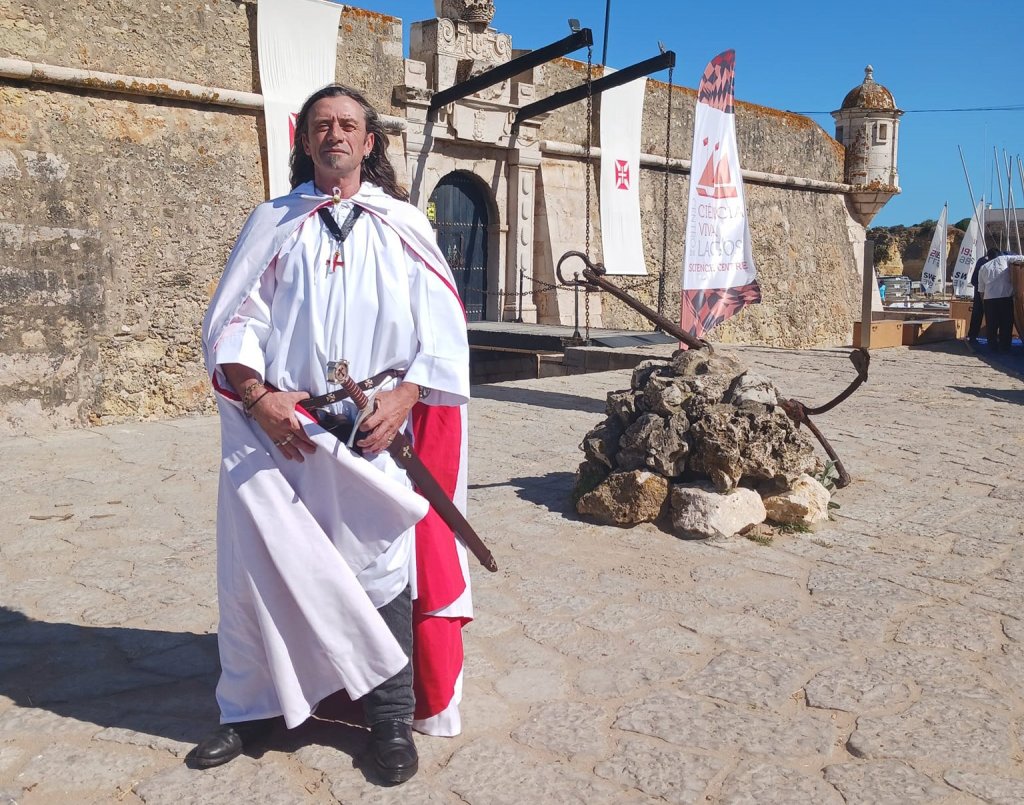


Secular Templi visita o país Templário de Almourol e Tomar
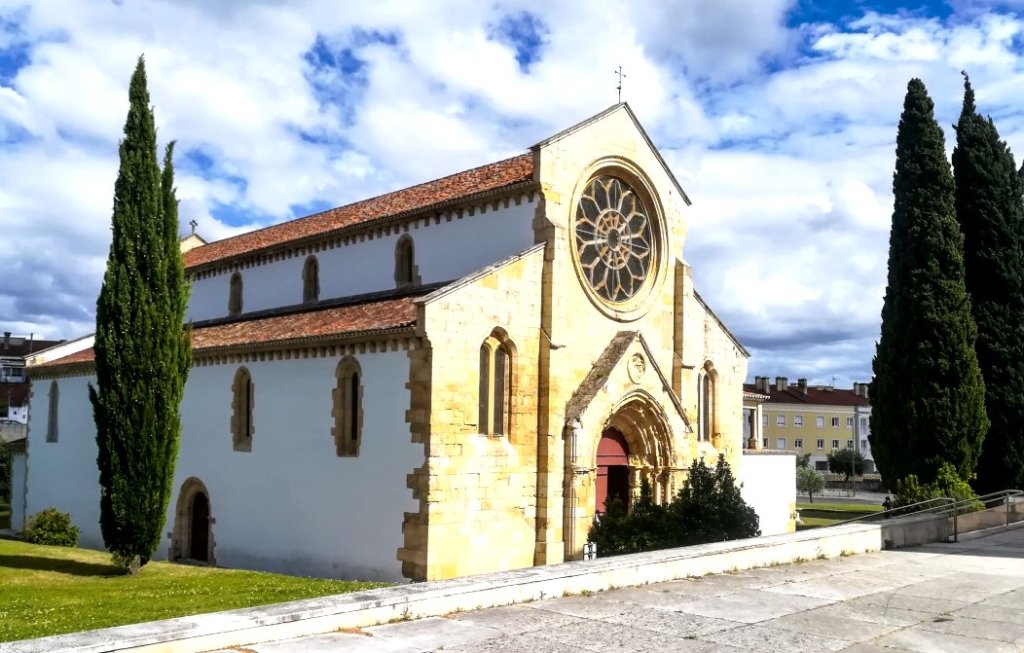
Realizou-se este Domingo, 30 de Abril de 2023, uma visita de estudo dos membros Portugueses da OSMTHU – Secular Templi. Guiada pelo Grão Prior de Portugal e Chanceler da Ordem, F+ Luis de Matos, a visita iniciou-se no Centro de Interpretação Templário de Vila Nova da Barquinha, onde todo o contexto Templário da zona geográfica visitada foi explicado. Além do Centro, obra apoiada pela Ordem e pelo Templar Corps International, procedeu-se a uma curta visita à Biblioteca dedicada ao tema Templário, convidando-se todos os presentes a fazerem doações em valor e em material para poder ampliar este equipamento de referência internacional.

De seguida o numeroso grupo dirigiu-se ao cais de Almourol, onde apanhou a embarcação que o levou à ilha emblemática. O dia estava magnífico, com um glorioso céu azul, sem nuvens e uma temperatura muito agradável.
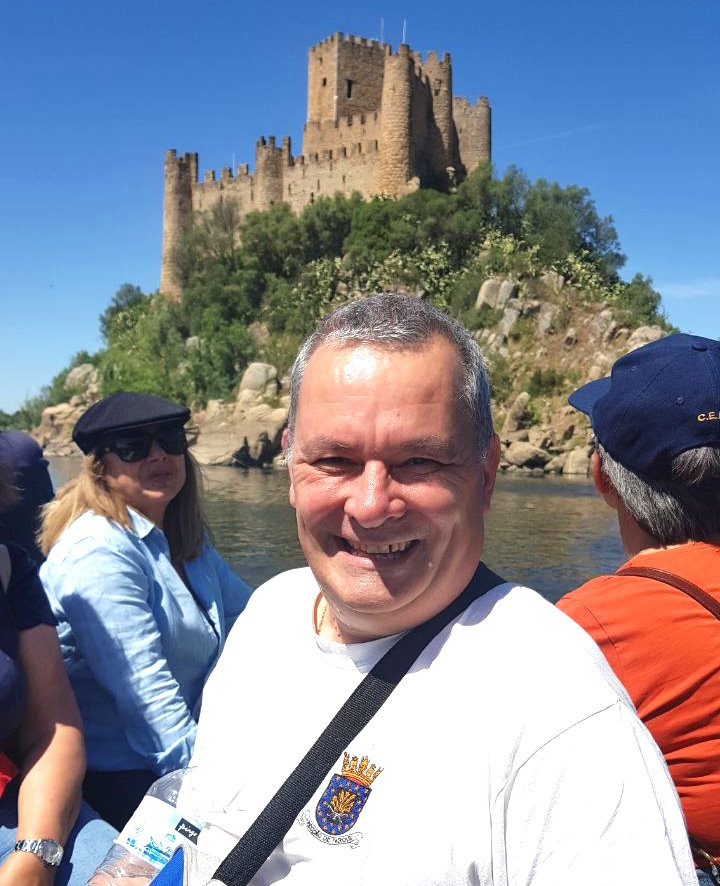
A escalada é difícil – afinal é um castelo defensivo Templário com centenas de anos! – mas muitos chegaram ao topo da Torre de Menagem de onde se desfruta uma vista impressionante do rio Tejo e das suas margens.
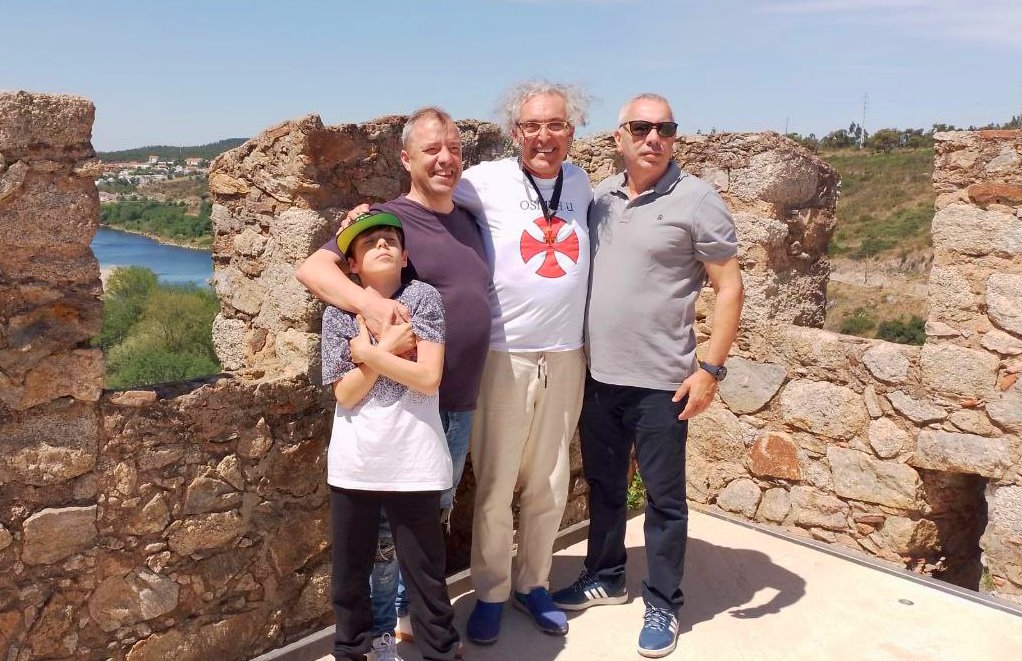
Já na cidade de Tomar o grupo fez uma visita à igreja de São João Baptista, recentemente restaurada, onde alguns dos detalhes mais surpreendentes foram destacados e explicados.

No largo, frente à Câmara Municipal, falou-se um pouco do impressionante percurso de Gualdim Pais, o mais influente e conhecido Mestre do Templo em Portugal, cuja obra inclui a fundação do Castelo de Tomar em 1160 e de Almourol em 1171.

Seguiu-se o almoço, de tom medieval, na Taverna Antiga de Tomar, onde o mais saudável convívio fraternal ajudou a preparar uma tarde de passeio. Dali, o grupo seguiu para a igreja de Santa Maria do Olival, mais um importante marco religioso da presença Templária na região. Assim se concluiu um dia maravilhoso em que a história da Ordem do Templo e a sua memória serviram de inspiração para três dezenas de peregrinos ao país do Templo.
Outras visitas estão em preparação para breve.
Info: templi@seculartempli.org

[ENGLISH]
This Sunday, April 30, 2023, a study visit was organized by the Portuguese members of OSMTHU – Secular Templi. Guided by the Grand Prior of Portugal and Chancellor of the Order, F+ Luis de Matos, the visit began at the Templar Interpretation Center of Vila Nova da Barquinha, where the entire Templar context of the geographical area visited was, explained. In addition to the Center, a work supported by the Order and by the Templar Corps International, a short visit was made to the Library dedicated to the Templar theme, inviting all those present to make donations in value and material in order to expand this equipment of international reference.
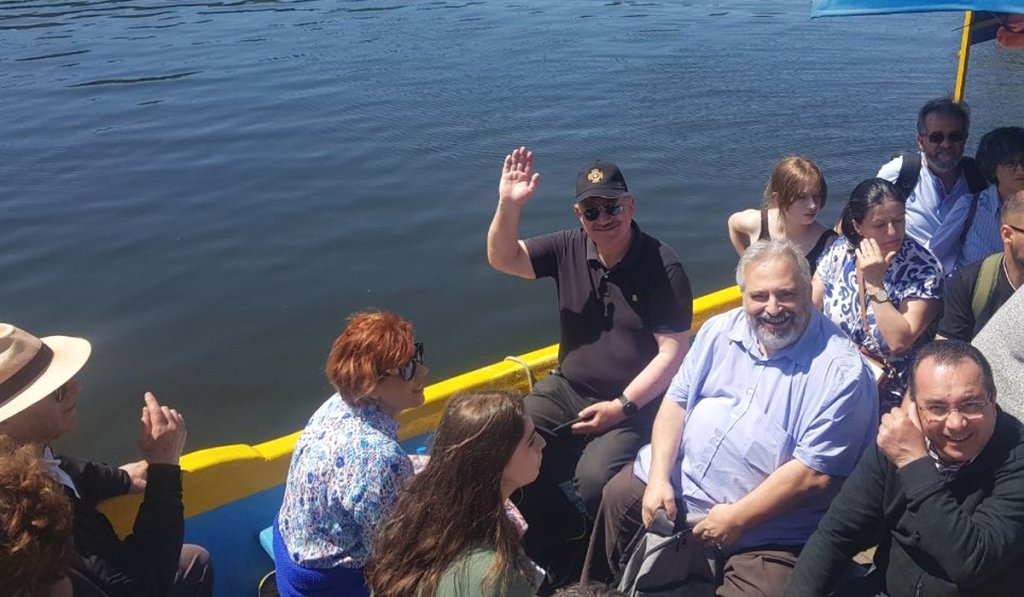
Then the large group headed to the Almourol pier, where they borded the boat that took them to the emblematic island. The weather was magnificent, with a glorious blue sky, without clouds and a very pleasant temperature. The climb is tough – it is a Templar defensive castle hundreds of years old after all! – but many reached the top of the Tower from where you can enjoy an impressive view of the Tagus River and its banks.
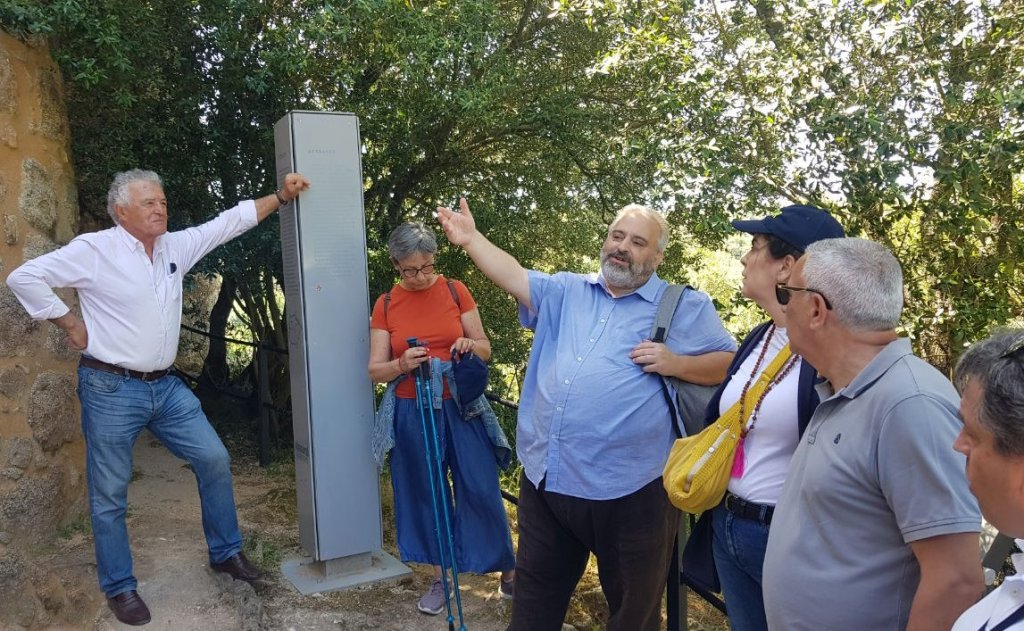
Once in the city of Tomar, the group visited the church of São João Baptista, recently restored, where some of the most surprising details were highlighted and explained. In the square, in front of the Town Hall, the Prior talked about the impressive career of Gualdim Pais, the most influential and well-known Master of the Temple in Portugal, whose work includes the founding of the Castle of Tomar in 1160 and of Almourol in 1171.
This was followed by lunch, in a medieval style, at Taverna Antiga de Tomar, where the healthiest fraternal interaction helped to prepare the afternoon.

From there, the group headed to the church of Santa Maria do Olival, another important religious landmark of the Templar presence in the region. Thus ended a wonderful day in which the history of the Order of the Temple and its memory served as an inspiration for three dozen pilgrims to the country of the Temple.
Other visits are in preparation for the near future.
Info: templi@seculartempli.org
Un posible vestigio templario aparece en el Coia rural

El especialista en el Temple, Venancio R. Riobó y Descifrando la Tierra localizaron una cerradura que el Museo de la Cerradura de Barcelona identifica con modelos del siglo XIII
La presencia del Temple en Vigo, concretamente en Coia, podría tener una pieza más que la avale. Así lo cree Venancio Rodríguez Riobóo, autor del libro “Los templarios en la comarca de Vigo” y caballero de la Osmth (Orden Soberana y Militar del Temple de Jerusalén). Se basa en un reciente hallazgo, una cerradura antigua localizada en terrenos de la zona más rural de Coia, donde se atribuye la presencia del bailial, la base central que la Orden templaria en el siglo XIII, documentada desde 1232.
“Es un objeto sin valor material, ni artístico, pero que tiene una gran importancia patrimonial si se relaciona con el Temple”, apunta Rióboo, que inspeccionó la zona tras la erosión de las lluvias en compañía de Óscar Domínguez, José Luis Correa y Juan Carlos Álvarez, integrantes del grupo aficionado de geología y mineralogía Descifrando la tierra.
Consultado Jaume de Balaguer, director del Museo del Pany y la Clau (de la llave y la cerradura) de Barcelona, identificó el modelo como similar a los que se utilizaban de manera habitual entre los siglos XIII y XIV, aunque no lo confirmó, “la respuesta resultó muy esperanzadora”, en palabras del investigador.
Para poder datar la boca-llave es necesario realizar un examen metalográafico que determine su composición, tal y como explicó el arqueólogo Eduardo Rodríguez Sainz, técnico al que les dirigieron desde Patrimonio. Se realizó una primera limpieza para eliminar la capa de sedimento y mineralización. También se le ha dado un primer tratamiento de consolidación para detener la acusada pérdida de material en algunas zonas y un examen de rayos X. “A la espera de un examen más concluyente podemos soñar con que la enorme cerradura perteneció a la desaparecida iglesia romántica de Coia o a alguna de las puertas de la antigua bailía”, afirmó Rodríguez Riobóo, que en la misma zona dio con sillares del templo medieval con la marca del cantero reutilizados en construcciones posteriores.
in Atlantico.net
704th Anniversary of the Order of Christ Celebrated With New Knights

The 704th anniversary of the Papal Bull promulgating the Order of Christ – the 1319 Portuguese metamorphosis of the Order of the Temple – was celebrated by the Secular branch of the OSMTHU with the reception of nine new Knights. The ceremony took place at the Church of the Castro Marim castle, first seat of the Order of Christ, that served as headquarters for almost half a century before returning to Tomar, the emblematic Templar City of Portugal.
The celebrations started with a public debate on March 14, at the Medieval Tavern in Castro Marim. The Grand Prior of Portugal OSMTHU, Fr+ Luis de Matos, addressed some of the most controversial claims about the founding of the Tamplar Order, explaining how the main focus had always been mainland Europe where the Provinces of the Order ruled over vast territories in full autonomy of King and local Clergy.
Military operations in the Holy Land where conducted by the Outremére Province and, although the Master was elected there, very close to the Eastern border, operations of the Western Crusade (later called Reconquista, in the Iberian Peninsula) were so important to the Order, that some exceptional privileges were granted by the Pope and Iberian Kings. This would prove to be crucial when Philip IV arrested Templars in France and unsuccessfully tried to make other kingdoms follow him.

Many of those present were interested in discussing the role os Castro Marim as the first headquarters of the Order of Christ, as well and the transition period between the Temple and the new Order. In a poetic moment, Fr+ Bruno Correia, Preceptor of Castro Marim, read the definition of the acclaimed poet Fernando Pessoa (b. 1888, d. 1935) for the Order of Christ. Having been extinct in 1834, along all other religious Orders in Portugal, the questions related to possible survival of the Order were discussed with enthusiasm.
The proceedings on Saturday started early in the morning, with a final address from the Grand Prior to the postulants. The three previous Instruction meetings were summarized and a final synthesis about the Order, Chivalry and what a Knight should study and bring to the world was made.

The Preceptory invited the Postulants and family to lunch at the headquarters of the Banda Musical Castromarinense. It was a precious moment of fun and fraternal friendship that preceded the afternoon ceremonies.
In the afternoon all reunited in the courtyard in front of the Church, inside the tall walls of the Castle. The interior had been duly prepared and decorated for the ceremony. The present Church building dates from the 16th century, although the foundations go back to the 12th century, originally dedicated to Saint John and later rededicated to Saint James. By the 16th century, three images were present tat the altar, according to “Visitation” reports found in the National Archives: Saint James, Saint John and Saint Sebastian, the latter having been recently added. Saint Sebastian iconography is very significant and would later be intertwined with the myth of King Sebastian, lost in Battle that would one day return, mounted on a shiny white horse.
There was an inner circle of Postulants, Knights and Dames from both branches of the Order. Around them the invited guests had their seats, bearing witness of how Chivalry is transmitted. You could hear a pin drop, so attentive and focused were the invited guests.

The Grand Prior read a few paragraphs on the subject of Templar legacy, explaining how and why the medieval organization had its period of manifestation and cannot be brought back to existence from the same dead body. He stressed however that the Order is not perishable by fire and that Philip IV was unable to suppress it. “The light that shone in Jerusalem that very day the Templars gathered around the same lamp to pray for the first time, is the same light that guides the Order today”, he said.
Each of the postulants was called by name and kneeled to proclaim their public commitment. Then the Grand Prior armed them by following the traditional ritual, using the sword and words in gesture and speech that have hundreds of years. The Commander of Lagos, Fr+ Victor Varela Martins, dressed the new Knights with their mantle, giving them the sword, certificate and the “Liber Novitius” the book published by the Grand Preceptory of the Order where all the historical information is referenced and explained, including the Primitive Rule.

The Proceedings of the Day closed with the congregation singing the Non Nobis. It was a joyful day for the Order, with nine new Secular Knights. They are B+ Luis Velez, B+ Luís Moutinho, B+ Luís Matos, B+ Nuno Moreira, B+ Carlos Carmo, B+ Amadeu Silvestre, B+ José Elias, B+ António Santos Rosa e B+ Jorge Santos.
The evening was crowned with a convivial Medieval Dinner, that included a live performance of medieval music, Troubadour songs and some beautiful pieces from Al-Andaluz and Sufi tradition.
The Order can be contacted by email: templi@seculartempli.org
PORTUGUESE TEXT

O 704º aniversário da Bula Papal que promulgou a Ordem de Cristo – a metamorfose portuguesa de 1319 da Ordem do Templo – foi celebrado pelo Ramo Secular da OSMTHU com a recepção de nove novos Cavaleiros. A cerimónia decorreu na Igreja do castelo de Castro Marim, primeira sede da Ordem de Cristo, que serviu de assento durante quase meio século antes de regressar a Tomar, a emblemática Cidade Templária de Portugal.
As comemorações começaram com um debate público no dia 14 de março, na Taberna Medieval de Castro Marim. O Grão Prior de Portugal OSMTHU, F+ Luís de Matos, abordou algumas das teses mais controversas sobre a fundação da Ordem dos Tamplários, explicando como o foco principal sempre foi a Europa continental onde as Províncias da Ordem governavam vastos territórios em total autonomia de Rei e Clero local. As operações militares na Terra Santa foram conduzidas pela Província de Ultramar e, embora o Mestre fosse aí eleito, muito perto da fronteira oriental, as operações da Cruzada Ocidental (mais tarde denominada Reconquista, na Península Ibérica) foram tão importantes para a Ordem, que alguns privilégios excepcionais foram concedidos pelo Papa e pelos Reis Ibéricos. Isso seria crucial à época em que Filipe IV prendeu os Templários na França e tentou, sem sucesso, fazer com que outros reinos o seguissem.

Muitos dos presentes mostraram-se interessados em discutir o papel de Castro Marim enquanto primeira sede da Ordem de Cristo, bem como o período de transição entre o Templo e a nova Ordem. Num momento poético, o F+ Bruno Correia, Preceptor de Castro Marim, leu a definição do aclamado poeta Fernando Pessoa (n. 1888, d. 1935) para a Ordem de Cristo. Extinta em 1834, juntamente com todas as outras Ordens religiosas em Portugal, as questões relativas à eventual sobrevivência da Ordem foram de seguida discutidas com entusiasmo.
Os trabalhos de sábado começaram no início da manhã, com o discurso final do Grão Prior aos postulantes. Foram resumidas as três reuniões de Instrução anteriores e feita uma síntese final sobre a Ordem, a Cavalaria e o que um Cavaleiro deve estudar e trazer ao mundo.
A Preceptoria convidou os Postulantes e familiares para um almoço na sede da Banda Musical Castromarinense. Foi um precioso momento de diversão e amizade fraterna que antecedeu as cerimónias da tarde.

À tarde, todos se reuniram no pátio em frente à Igreja, dentro das altas muralhas do Castelo. O interior foi devidamente preparado e decorado para a cerimónia. O actual edifício da Igreja data do século XVI, embora as fundações remontem ao século XII, sendo originalmente dedicada a São João e depois rededicada a São Tiago. No século XVI, três imagens estavam presentes no altar, segundo relatórios de “Visitação” encontrados no Arquivo Nacional: São Tiago, São João e São Sebastião, este último tendo sido acrescentado havia pouco tempo. A iconografia de São Sebastião é muito significativa e mais tarde entroncaria no mito de El-Rei D. Sebastião, desaparecido em Batalha e que um dia retornaria, montado em um cavalo branco reluzente.
Na igreja havia um círculo interno de Postulantes, Cavaleiros e Damas de ambos os ramos da Ordem. À sua volta sentaram-se os convidados, testemunhando como se transmite a Cavalaria. Podia ouvir-se um alfinete cair, de tão atentos e concentrados estavam os convidados.

O Grão Prior leu alguns parágrafos sobre o tema do legado Templário, explicando como e por quê a organização medieval teve seu período de manifestação e não pode ser trazida de volta à existência a partir do mesmo cadáver. Enfatizou, no entanto, que a Ordem não é perecível pelo fogo e que Filipe IV não foi capaz de suprimi-la. “A luz que brilhou em Jerusalém naquele mesmo dia em que os Templários se reuniram em torno de uma lâmpada para rezar pela primeira vez, é a mesma luz que hoje guia a Ordem”, afirmou.
Cada um dos postulantes foi chamado pelo nome e ajoelhou-se para proclamar o seu compromisso público.

Então o Grão-Prior armou-os, seguindo o ritual tradicional, usando a espada e palavras, gestos e falas que têm centenas de anos. O Comendador de Lagos, F+ Victor Varela Martins, vestiu os novos Cavaleiros com o seu manto, entregando-lhes a espada, certificado e o “Liber Novitius” livro editado pela Grande Preceptoria da Ordem onde toda a informação histórica é referenciada e explicada, incluindo a Regra Primitiva.

Os procedimentos do Dia encerraram com o canto do Non Nobis. Foi um dia de alegria para a Ordem, com nove novos Cavaleiros Seculares. São eles os I+ Luis Velez, I+ Luís Moutinho, I+ Luís Matos, I+ Nuno Moreira, I+ Carlos Carmo, I+ Amadeu Silvestre, I+ José Elias, I+ António Santos Rosa e I+ Jorge Santos.

A noite foi coroada com um Jantar Medieval de convívio, que incluiu uma actuação ao vivo de música medieval, com canções trovadorescas e algumas belas peças da tradição Al-Andaluz e Sufi.
A Ordem pode ser contactada pelo e-mail: templi@seculartempli.org
Secular Templi
Castro Marim, Portugal




Congratulations to new Knights and Dames B+ Jaime Ramos, S+ Sandra Oliveira, B+ Luis Guerreiro, B+ Jorge Campos Inácio, B+ Paulo Guerreiro, B+ Alberto dos Santos, B+ Rui Cardoso, B+ Stuart Balbino, B+ Henrique André, B+ Fernando Júnior, S+ Iris Vicente, B+ Carlos Estanislau, S+ Ana Mendonça.
Gaztelugatxe – Hundreds of stone stairs and a winding medieval bridge connect this haunting Spanish island to the mainland

SITTING OFF THE BASQUE COAST of Spain, the tiny island of Gaztelugatxe would probably just be another tiny isle left off of maps and all but forgotten, were it not for the fantastical stone bridge and famed steps that connect its single hermitage to the mainland.
Today, the crooked stone bridge that connects Gaztelugatxe to the shore looks more like something that one might see on Game of Thrones, but when it was originally built in the 11th century, the span was simply a sturdy lifeline to the religious hermitage erected atop the sea crag. The structure, along with its attendant stone path seems to have been established by the Knights Templar. Down the centuries, the little church has been sacked, burned, and otherwise destroyed, but was rebuilt each time.

The church is still standing on the little rock, looking, maybe more enticing than ever, its history simply adding to its charm. The ancient bridge and the hundreds of stairs leading up to the church are still a popular tourist attraction and can be accessed by a well-groomed modern path. Along the bridge are smaller staircases that lead down to reflecting spots at the edge of the water. The hermitage can also be visited, and legend says that after ascending the old staircase, visitors should make a wish.
Whether or not you are interested in ancient construction or churches at all, doesn’t really matter as this spot can just as easily be appreciated for its uncanny resemblance to a location you might use in a Dungeons & Dragons game.
in atlasobscura.com
